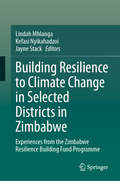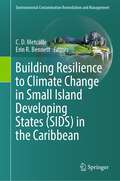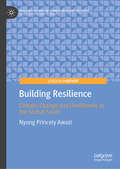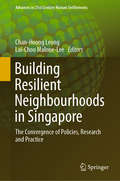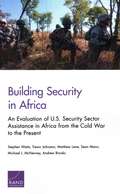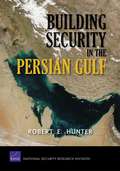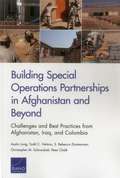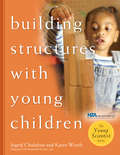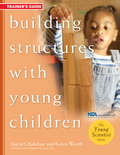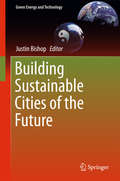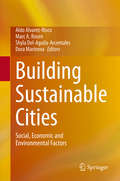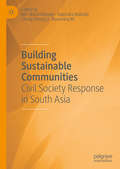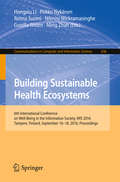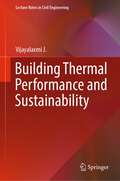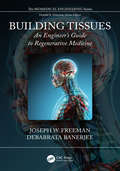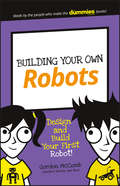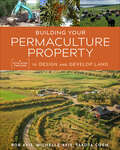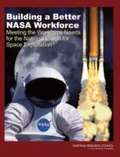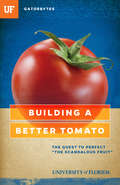- Table View
- List View
Building Resilience to Climate Change in Selected Districts in Zimbabwe: Experiences from the Zimbabwe Resilience Building Fund Programme
by Lindah Mhlanga Kefasi Nyikahadzoi Jayne StackThe book is based on Zimbabwe Resilience Building Fund data from the Outcome Monitoring Surveys 1,2,3 (OMS123) which comprised of three rounds of panel data set with the same households being interviewed three consecutive times in 18 districts. The OMS1, OMS2 and OMS3 were undertaken in 2019, 2020 and 2021, respectively. The findings in this book demonstrate and provide a better understanding of what works and what does not work to strengthen communities’ resilience in Zimbabwe. The information contributed in each chapter will be useful to inform adaptive programming and design of future resilience interventions and policy, with a focus on Climate Resilient Development (CRD). The chapters also address the challenge of formulating concrete policy in an environment with severe data constraints.
Building Resilience to Climate Change in Small Island Developing States (Environmental Contamination Remediation and Management)
by C. D. Metcalfe Erin R. BennettThis book summarizes approaches that integrate the environmental, economic, and physical domains with the values, and needs of the population are necessary to develop sustainable strategies that will enhance the resilience of small islands, within the context of inter-island differences in geology, ecology, societal attitudes, governance, and human and economic resources. The impacts of coastal damage and flooding are predicted to worsen during this century due to rising sea levels and increases in the frequency and intensity of storms. The usual approach to coastal protection in Small Island Developing States (SIDS) in the Caribbean is to view both the hazards and the solutions from the “Ocean Side” perspective and to react with “hard” engineering solutions. These structural engineering approaches prevent damage and disruptions to services associated with predictable events but leave communities vulnerable to future events that do not follow historical trends. Furthermore, engineered structures do not adequately address the systemic nature of climate change nor account for compounding threats (e.g., coincidence of hurricane season and global pandemics). To move from this traditional strategy for managing risks from coastal hazards, we need to consider a portfolio of solutions that enhance island protection and community resilience. Nature-Based Solutions (NBS) are gaining attention as practical and cost-effective approaches for mitigating climate-based stressors. However, deployment of NBS strategies requires spatial coordination within the context of “ridge to reef” or integrated water resource management (IWRM) approaches that include the creation of conditions for social acceptance, equity, effective governance, and financial incentives.
Building Resilience: Climate Change and Livelihoods in the Global South (Palgrave Studies in Climate Resilient Societies)
by Nyong Princely AwaziThis book explores the intersection of climate resilience, livelihoods, and sustainability in various sectors – from forestry to fisheries and agriculture – within the global South. The author provides a comprehensive examination of how climate change impacts these communities, the adaptive strategies they employ, and the policy frameworks necessary for promoting resilience. Through a multidisciplinary approach that integrates ecological, economic, and social dimensions, this book is an essential resource for policymakers, researchers, and practitioners in fields relating to fishery, forestry and agriculture in the global South.
Building Resilient Neighbourhoods in Singapore: The Convergence of Policies, Research and Practice (Advances in 21st Century Human Settlements)
by Chan-Hoong Leong Lai-Choo Malone-LeeThis book examines how institutional and environmental features in neighbourhoods can contribute to social resilience, highlighting the related socio-demographic issues, as well as the infrastructure, planning, design and policies issues. It is divided into three themes – infrastructure, planning, and community. Infrastructure examines how physical features such as parks and street patterns influence neighborliness and resilience, while planning studies how urban design enhances social interactions. Lastly, community discusses policies that can forge social bonds, either through racial integration, grassroots activities, or social service. Overall, the book combines research and empirical work with scholarly models of resilience and governance philosophy, focusing on Singapore’s urban planning and social policies.
Building Resilient and Healthy Cities: A Guide to Environmental Sustainability and Well-being (Advances in Science, Technology & Innovation)
by Anna Laura Pisello Stephen Siu Yu Lau Ilaria Pigliautile Nancy M. ClarkThis book presents a number of research papers that discuss how green urbanism is connected to promoting healthier living conditions. This is to reduce the impact of environmental changes including climate change, depletion of the earth's resources, and the emergence of infectious diseases and pandemics on humans. Addressing these challenges, the book at hand offers strategies and solutions that enable designers to bring together knowledge about sustainable and comfortable urban built environments, with an emphasis on the correlation between architecture, engineering, and medical facets in regard to comfort and well-being. Thus, the book is of significant importance to architects interested in the science of the built environment, climate change, and human resilience. This book is a culmination of selected research papers from the first version of the international conference on "Health & Environmental Resilience and Livability in Cities (HERL) - The challenge of climate change" which was held online in 2022 in collaboration with the University of Perugia, Italy, and the fifth edition of the international conference on Green Urbanism (GU) which was held online in 2021 in collaboration with the University of Rome.
Building Scientific Apparatus
by John H. Moore Christopher C. Davis Michael A. Coplan Sandra C. GreerSubtitled A practical guide to design and construction, this useful manual treats mechanical design, glass, optics, electronics, and temperature measurement and control. Annotation copyrighted by Book News, Inc. , Portland, OR
Building Security in Africa: An Evaluation of U.S. Security Sector Assistance in Africa from the Cold War to the Present
by Stephen Watts; Trevor Johnston; Matthew Lane; Sean Mann; Michael J. McNerney; Andrew Brooks;A RAND Corporation study used statistical models to evaluate the impact that U.S.-provided SSA has had on political violence in Africa--in particular, the incidence of civil wars and insurgencies, terrorist attacks, and state repression.
Building Security in the Persian Gulf
by Robert E. HunterThe United States must determine how best to promote long-term security and stability in the Persian Gulf region while seeking to reduce the risks and costs imposed by its role as a permanent regional power. The author analyzes Iraq's future, the role of Iran, asymmetric threats, regional reassurance, regional tensions, and the roles of other external actors. He then sets out criteria and requirements for a new regional security structure.
Building Simple Traps (Fun STEM Challenges)
by Marne VenturaWhat does it take to make a simple trap? Gather some supplies and try it out for yourself! Discover tips and ideas on how to build the best trap around!
Building Special Operations Partnerships in Afghanistan and Beyond: Challenges and Best Practices from Afghanistan, Iraq, and Colombia
by Peter Chalk Austin Long Todd C. Helmus S. Rebecca Zimmerman Christopher M. SchnaubeltBuilding the capacity of Afghan special operations forces (SOF) is a key goal of the United States and its coalition partners. This report summarizes key partnering practices and presents findings from SOF partnership case studies in Afghanistan, Iraq, and Colombia. The goal is to identify best practices to benefit the development of Afghan SOF, as well as for special operations partnerships beyond Afghanistan.
Building Strong Bridges (Fun STEM Challenges)
by Marne VenturaWhat does it take to make a strong bridge? Gather some supplies and try it out for yourself! Discover tips and ideas on how to build the best bridge around!
Building Structures with Young Children
by Karen Worth Ingrid ChalufourFrom playground equipment to skyscrapers, structures are everywhere. The second unit in the Young Scientist series, Building Structures with Young Children guides children's explorations to help deepen their understanding of the physical science present in building block structures--including concepts such as gravity, stability, and balance. Looking at science in a new way, this nationally field-tested curriculum supports the early development of important science inquiry skills such as questioning, investigating, discussing, and formulating ideas and theories.
Building Structures with Young Children--Trainer's Guide
by Karen Worth Ingrid ChalufourA companion to the curriculum, this trainer's guide serves as an indispensable handbook for trainers and administrators interested in introducing staff to the Building Structures with Young Children curriculum--from planning to implementation. Special sections outline the curriculum and introduce scientific reasoning to adults, and eight workshops detail the complete curriculum for staff members. The guide also includes strategies for supporting teachers over time through mentoring and guided discussions.
Building Sunshades (Fun STEM Challenges)
by Marne VenturaWhat does it take to make a sunshade? Gather some supplies and try it out for yourself! Discover tips and ideas on how to build the best sunshade around!
Building Sustainable Cities of the Future (Green Energy and Technology)
by Justin BishopThis book draws upon the expertise of academic researchers, urban planners and architects to explore the challenge of building the sustainable cities of the future. It addresses this challenge by considering current cities and those of the near future, and creates a picture of the sustainable city from the bottom up. Individual chapters cover topics such as transport, energy supply, sustainable urbanism and promoting social equality in large infrastructure projects. Real-world examples are presented to illustrate how systems thinking is used to integrate different components of a city so as to ensure that the whole is more sustainable than its parts. Written in an accessible style, this book is intended for general readers as much as it is for students and researchers interested in sustainable cities and related topics. It is also ideal for urban planners seeking best-practice guidelines for sustainable urban development.
Building Sustainable Cities: Social, Economic and Environmental Factors
by Marc A. Rosen Aldo Alvarez-Risco Dora Marinova Shyla Del-Aguila-ArcentalesThis book describes a broad view of sustainability as a crucial factor for the success of its implementation. Not only the environmental aspects of the sustainable cities´ development are reviewed but the economic and social aspects of it, as highlighted in the UN Sustainable Development Goal 11 (make cities and human settlements inclusive, safe, resilient and sustainable).Nowadays, researchers, students, and stakeholders are highly involved in sustainability issues. Because of this, they need a guiding document to help them develop and implement sustainability programs at the level of companies and institutions.In this book, the authors discuss and explain basic concepts of sustainability-related to social, economic and environmental aspects, as well as strategies for its implementation.
Building Sustainable Communities: Civil Society Response in South Asia
by Rajendra Baikady Md. Nurul Momen Cheng Sheng Li M. BasavarajThe book aims to explore South Asian third sector – the nonprofit organizations as provider of social services. The book defines social welfare and describe its relationship to social service programmes and individual well-being; understands the social policy development from the problem identification to policy implementation; describes the range of organization of social service agencies that are responsible for providing social welfare programmes; explores the various roles that professional and non- professional helpers provide in the delivery of social welfare and their influence in promoting change in policy development; and understands the umbrella concept of Child welfare, welfare of people with disability and elderly welfare in welfare policy.
Building Sustainable Health Ecosystems: 6th International Conference on Well-Being in the Information Society, WIS 2016, Tampere, Finland, September 16-18, 2016, Proceedings (Communications in Computer and Information Science #636)
by Nilmini Wickramasinghe Reima Suomi Hongxiu Li Pirkko Nykänen Gunilla Widén Ming ZhanThis book constitutes the refereed proceedings of the 6th International Conference on Well-Being in the Information Society, WIS 2016, held in Tampere, Finland, in September 2016. The 21 revised full papers presented were carefully reviewed and selected from 42 submissions. With the core topic "Building Sustainable Health Ecosystems" WIS 2016 focused on innovations and fresh ideas in the cross-section of urban living, information society and health as understood in a wide sense. The papers presented in this volume are organized along the following seven broad topics: 1. Macro level considerations of e-health and welfare, 2. Welfare issues of children, youth, young elderly and seniors, 3. Analytics issues of eHealth and welfare, 4. National/regional initiatives in eHealth and welfare, and 5. Specific topics of eHealth. The papers in these topics span qualitative and quantitative analysis, empirical surveys, case studies as well as conceptual work.
Building Thermal Performance and Sustainability (Lecture Notes in Civil Engineering #316)
by Vijayalaxmi J.This book highlights the various aspects of architectural research based on field studies and real-time data including the data collection methods and the methodology and materials required. The output of every study is knowledge based and informed decision that helps architects and designers in decision making process at an early stage. The output of the book bridges the architectural research methods and its application in contemporary world through a thorough understanding of sustainable building materials, construction techniques and its quantified consequences on thermal performance. This book is aimed at researchers and professionals to assist in understanding the strategies, tacts and methods of a scientific approach to assess building performance through real-life case studies from India. The implication of what is being done in the contemporary world is highlighted which will help practicing architects make design decisions.
Building Tissues: An Engineer's Guide to Regenerative Medicine (Biomedical Engineering)
by Joseph W. Freeman Debabrata BanerjeeTissue engineering uniquely applies concepts and techniques from biology and engineering in order to heal or produce new tissues after disease or traumatic injury. A successful tissue engineer must have knowledge of cellular biology, cell signaling, extracellular matrix development, and tissue structure and integrate it with the application of stresses and strains, mass transfer, mechanical properties, and heat transfer. In order to train the next generation of successful tissue engineers, this text gives the reader a background in both the engineering and biology associated with tissue engineering.
Building Tough Towers (Fun STEM Challenges)
by Marne VenturaWhat does it take to make a tough tower? Gather some supplies and try it out for yourself! Discover tips and ideas on how to build the best tower around!
Building Your Own Robots: Design and Build Your First Robot! (Dummies Junior)
by Gordon McCombFun robotics projects that teach kids to make, hack, and learn! There's no better way for kids to learn about the world around them than to test how things work. Building Your Own Robots presents fun robotics projects that children aged 7 – 11 can complete with common household items and old toys. The projects introduce core robotics concepts while keeping tasks simple and easy to follow, and the vivid, full-color graphics keep your kid's eyes on the page as they work through the projects. Brought to you by the trusted For Dummies brand, this kid-focused book offers your child a fun and easy way to start learning big topics! They'll gain confidence as they design and build a self-propelled vehicle, hack an old remote control car to create a motorized robot, and use simple commands to build and program a virtual robot—all while working on their own and enjoying a sense of accomplishment! Offers a kid-friendly design that is heavy on eye-popping graphics Focuses on basic projects that set your child on the road to further exploration Boasts a small, full-color, accessible package that instills confidence in the reader Introduces basic robotics concepts to kids in a language they can understand If your youngster loves to tinker, they'll have a whole lot of fun while developing their creative play with the help of Building Your Own Robots.
Building Your Permaculture Property: A Five-Step Process to Design and Develop Land (Mother Earth News Wiser Living Ser.)
by Rob Avis Michelle Avis Takota Coen&“A fresh, integrative, and holistic perspective on how to orientate oneself to the process of establishing your dreams and visions on the land.&” —Richard Perkins, author of Regenerative AgricultureBuilding Your Permaculture Property offers a revolutionary holistic method to overcome overwhelm in the complex process of resilient land design. It distills the authors&’ decades of experience as engineers, farmers, educators, and consultants into a five-step process complete with principles, practices, templates, and workflow tools to help you: Clarify your vision, values, and resources Diagnose your land and resources for strengths, weaknesses, opportunities, and threats Design your land and resources to meet your vision and values Implement the right design to enhance your strengths and improve your weakest resource Establish benchmarks to monitor the sustainability and success of your development. When designing a regenerative permaculture property, too many land stewards suffer from option paralysis, a lack of integrated holistic design, fruitless trial-and-error attempts, wasted money, and the frustration that results from too much information and no context.Building Your Permaculture Property is the essential guide for everyone looking to cut through the noise and establish an ecologically regenerative, financially sustainable, enjoyable, and thriving permaculture property, anywhere in the world. &“Highlights the need for permaculture design thinking in creating resilient, regenerative, landscapes and communities. Through this work, Rob, Michelle, and Takota make a valuable contribution to the ongoing evolution of permaculture thinking and action.&” —David Holmgren, permaculture co-originator &“Every farm, every ranch, and every homestead can benefit from thinking deeper about how human intent engages with the places we&’re blessed to call home.&” —Michael Phillips, author of The Holistic Orchard
Building a Better NASA Workforce: Meeting the Workforce Needs for the National Vision for Space Exploration
by National Research Council of the National AcademiesThe National Academies Press (NAP)--publisher for the National Academies--publishes more than 200 books a year offering the most authoritative views, definitive information, and groundbreaking recommendations on a wide range of topics in science, engineering, and health. Our books are unique in that they are authored by the nation's leading experts in every scientific field.
Building a Better Tomato: The Quest to Perfect "The Scandalous Fruit"
by Jeff Klinkenberg University of FloridaIn the search for a superior alternative to bland and mealy grocery-store tomatoes, horticultural scientist Harry Klee and renowned taste researcher Linda Bartoshuk teamed up and are hot on the trail of a specimen that will have you thinking you just picked it in your own back yard. Gatorbytes highlight for the intellectually curious the world of innovative research happening at the University of Florida. Written by professional journalists, Gatorbytes feature the top research and preeminence work being conducted at the University of Florida, written in a way that’s easy to understand.
